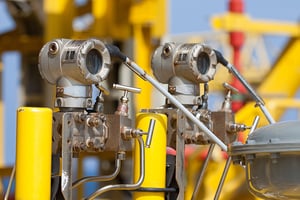What is Semiconductor Manufacturing?
Front-end semiconductor wafer manufacturing involves building integrated circuits on silicon wafers through tightly controlled steps like deposition, photolithography, etching, doping, and metrology. In these ultra-clean environments, Setra’s ultra-high purity (UHP) pressure transducers ensure contamination-free delivery of process gases and liquids, while vacuum capacitance manometers deliver precise vacuum and pressure readings during critical steps like etching and deposition. Together, these sensors form the pressure-monitoring backbone of wafer fabs, supporting process stability and high device yield.
Why is Ultra High Purity (UHP) Important?
The microscopic scale of modern circuits means that any contamination (e.g. particles, outgassed chemicals, residual moisture) can be detrimental. Here’s why UHP standards are non-negotiable:
- Product Yield and Cost: Achieving the required purity is difficult and expensive. Defects from impurities reduce the number of usable chips per wafer.
- Process Sensitivity: Every fabrication step, from cleaning to etching, must be performed with micron-level precision. Inefficient cleaning or contamination can cause entire batches to fail.
- Toxic Materials: Many processes use highly toxic, corrosive, or even pyrophoric gases. Ensuring leak-tightness and preventing exposure is essential for safety and regulatory compliance.

To meet these demands, Setra’s UHP Pressure Transducers and Vacuum Capacitance Manometers are manufactured in Class 100 and Class 1000 cleanrooms, respectively (ISO class 5 and 6) and undergo rigorous double-cleaning and double-bagging, and use only the highest-grade materials to meet rigid semiconductor specifications (like VIM/VAR 316L stainless steel with electropolished surfaces or nickel alloys).
Key Applications in Semiconductor Manufacturing
Gas Cabinets
Gas cabinets store and deliver specialty gases used in processes like chemical vapor deposition (CVD). These gases are often toxic or flammable, requiring precise pressure monitoring and leak detection.
Recommended Setra Products: Model 225 UHP pressure transducers and Model 321 gas cylinder weighing scale for reliable, contaminant-free monitoring.
Valve Manifold Boxes/Panels (VMB/VMPs)
VMBs and VMPs distribute gases to various tools and processes within the fab. Maintaining purity and preventing leaks is crucial.
Recommended Setra Product: Model 225 for high-purity, leak-tight gas distribution.
Integrated Gas Systems (IGS), Gas Sticks, and Gas Boxes
These modular systems manage the delivery of gases to process tools, especially in advanced 300 mm fabs.
Recommended Setra Product: Model 227 UHP transducer, designed for high-density, modular block gas sticks and panels, featuring a small swept sensor chamber for easy purgeability.
Front-End Process Chamber Monitoring
Front-end processes like etching, deposition, ion implantation, and lithography require precise control of vacuum and pressure to ensure vacuum chamber stability and detect leaks quickly and safely
Recommended Setra Products: Models 730, 223, 224, and 225 for accurate pressure and vacuum measurement in critical process chambers.
Semiconductor manufacturing is a complex, high-stakes process where purity and precision are paramount. UHP pressure transducers and vacuum manometers from Setra play a vital role in ensuring safe, efficient, and contamination-free operations across gas delivery, distribution, and process monitoring.
This is the third post in a series about environments for Setra's products. To see the previous post in the series, click here. To see the next post in the series, click here.



